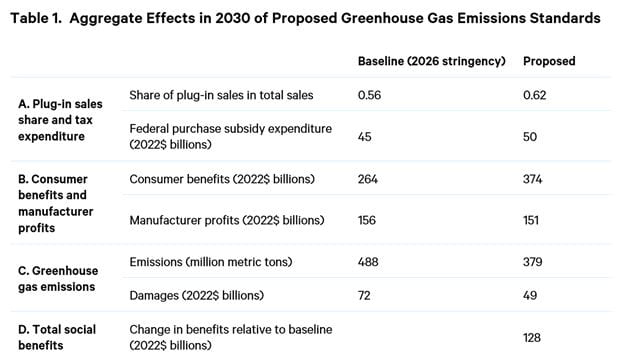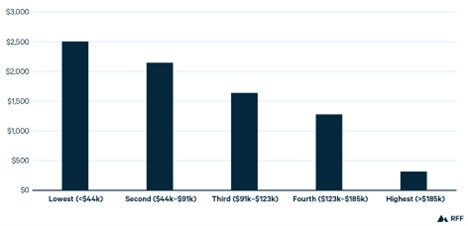The US Environmental Protection Agency (EPA) recently proposed greenhouse gas (GHG) emissions standards for passenger vehicles that would go a long way toward meeting the Biden administration’s objective of reducing GHG emissions. Passenger vehicles account for about 15 percent of US GHG emissions; between 2026 and 2032, the proposed standards would cut in half the average GHG emissions rates of new vehicles. EPA estimates that the standards would reduce US GHG emissions by about 10 percent by midcentury and yield benefits for consumers, air quality, and climate of approximately $48 billion to $120 billion per year.
This blog post summarizes a new report that asks: How would those benefits and costs be distributed across the consumers who purchase new vehicles? Using the light-duty vehicle model built by Resources for the Future researchers, I estimate that the proposed emissions standards would substantially increase overall social welfare and that lower-income households that buy new vehicles would disproportionately enjoy those benefits.
Despite the Biden administration’s interest in environmental justice and equity, the EPA analysis of the proposed standards does not quantify how the effects may vary across consumers. The standards will increase sales of plug-in vehicles while simultaneously making gasoline vehicles more fuel efficient. Both changes reduce fuel costs for drivers, which disproportionately benefits low-income households because they spend a much larger share of their income on gasoline than do high-income households. However, low-income households typically have lower demand for plug-in vehicles than high-income households (even putting aside the high up-front purchase price), and by shifting the market from gasoline to plug-in vehicles, the standards may reduce the purchasing options for low-income households.
The light-duty vehicle model that I used for the report monetizes the benefits and costs to new-vehicle buyers by income group, the costs to manufacturers, and the GHG reductions that result from the standards. Table 1 summarizes the main results for two scenarios: a baseline which assumes that the proposed standards for the year 2026 do not change in subsequent years (the same baseline that the EPA assumes), and a scenario that tightens the standards by about 40 percent between 2026 and 2030.

Notes: Outcomes are reported for the four categories of benefits that are described in the first column. Federal purchase subsidy expenditure is the value of total related subsidies under the Inflation Reduction Act for qualifying vehicles. Consumer benefits are estimated relative to the hypothetical of purchasing a used vehicle and represent the net benefits, considering purchase subsidies. Greenhouse gas damages are calculated using the estimates of the social cost of greenhouse gases proposed by the US Environmental Protection Agency. Social benefits are consumer benefits plus the net benefits of reductions in greenhouse gas damages. Changes in social benefits are computed relative to the baseline scenario.
The model shows that the baseline market share of plug-in vehicles will be about 56 percent in 2030, which is slightly higher than the Biden administration’s target (Table 1A). This market share lies in the middle of the wide range of recent forecasts. The model predicts that proposed standards would increase the market share of plug-in vehicles to 62 percent, which is comparable to EPA’s analysis (though slightly lower).
Expenditure on subsidies for plug-in vehicles under the Inflation Reduction Act is about $45 billion in the baseline scenario and $50 billion for the proposed standards (Table 1A). My calculation of the baseline expenditure is about 20 times greater than the estimate by the Joint Committee on Taxation, reflecting different assumptions about policies (such as the Zero-Emission Vehicle standards) and consumer preferences. However, my estimate is similar to other recent estimates that have used different computer models.
Table 1B shows the consumer benefits of purchasing vehicles in 2030. The estimate of consumer benefits measures the benefits of the vehicles compared with hypothetical purchases of used vehicles, instead. The proposed standards would increase consumer benefits by $110 billion.
The tighter GHG standards benefit consumers because people undervalue fuel cost savings when they purchase vehicles. Consider a hypothetical consumer who wants a particular vehicle and is offered the opportunity to purchase an otherwise identical vehicle that has lower fuel costs. Based on the purchase choices that consumers make, on average, a consumer is willing to pay about $35 for a hypothetical $100 reduction in fuel costs—in other words, people don’t pay as much as they should for the lower fuel costs. Consequently, consumers buy vehicles with higher fuel costs than is personally optimal for them. By addressing these mistakes, the standards can increase consumer welfare.
Manufacturer profits are the difference between revenue and total costs. The tighter standards would reduce manufacturer profits by about $5 billion. This result differs from EPA’s analysis, because the agency assumes that manufacturers raise prices sufficiently to cover their costs. In contrast, my modeling indicates that competition constrains the extent to which manufacturers can increase their prices. That is, if an individual manufacturer tries to increase its prices enough to offset its higher costs, it would lose customers to other manufacturers. This competitive pressure prevents manufacturers from fully passing costs to consumers.
Table 1C shows the GHG emissions (carbon dioxide and methane) from producing and consuming the gasoline and electricity that powers the vehicles. The proposed standards would yield climate benefits of about $23 billion.
Table 1D shows that the proposed standards would increase the aggregate social benefits by about $128 billion, where the benefits include the consumer benefits from purchasing new vehicles, manufacturer profits, and reductions in GHG emissions. The agency’s numbers are computed differently from the numbers reported in Table 1, so the two should not be compared explicitly. Rather, this table shows that both my analysis and EPA’s indicate large gains in benefits from the proposed standards.
Figure 1 shows how the benefits vary across consumers who purchase new vehicles, again comparing the proposed standards with the baseline. The figure plots the average welfare change per household, showing that the proposed standards would benefit the average household in the lowest-income group (below $44,000) by about $2,500. These benefits represent the net fuel cost savings relative to the total costs of the policy (such as paying higher vehicle prices), but do not include climate benefits nor local air-quality benefits.
Figure 1. Change in Consumer Benefits per Household for Proposed Greenhouse Gas Emissions Standards, Relative to Baseline

Notes: Changes in consumer benefits are estimated relative to a baseline scenario (i.e., standards set in 2026 that do not change in subsequent years). All scenarios are the same as those reported in Table 1.
That the bars diminish in height from left to right in Figure 1 means that the proposed standards would benefit low-income households more than high-income households. This pattern holds for other levels of stringency and other assumptions as described in my new report. The benefits concentrate among lower-income households because those households substantially undervalue fuel cost savings, whereas high-income consumers undervalue the savings by a moderate amount. If, hypothetically, GHG or fuel economy standards were not in place, then low-income consumers would buy vehicles that have higher fuel costs than would be optimal for them; the GHG standards benefit these consumers by reducing their fuel costs. In contrast, without standards, high-income consumers would buy vehicles that have only slightly higher fuel costs than would be optimal; thus, the standards give higher-income households smaller benefits.
An important factor underlying these results is that, according to the modeling, vehicle manufacturers will introduce many low-price electric vehicle options. If, hypothetically, vehicle manufacturers encounter challenges to producing and marketing low-price electric vehicles, then low-income consumers likely would benefit less from the proposed GHG standards than these results indicate. More generally, whether the benefits of plug-in vehicles are widespread across consumer income groups will depend on how consumer interest in those vehicles evolves and whether manufacturers can successfully introduce low-price plug-in options.
This post also appears on Resources for the Future’s Common Resources blog.